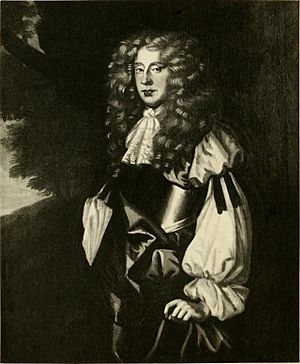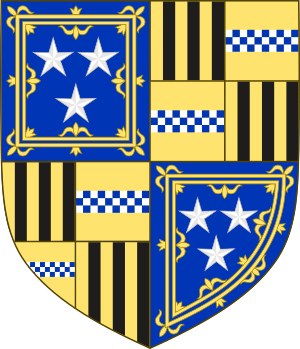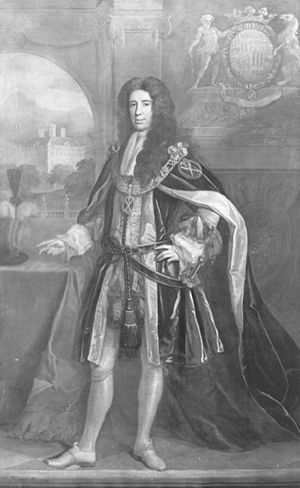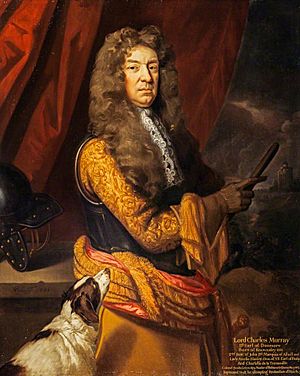John Murray, 1st Marquess of Atholl facts for kids
John Murray, 1st Marquess of Atholl (born 1631, died 1703) was a very important Scottish leader. He strongly supported the Stuart kings during a time of big changes in Scotland. This period included the English Civil War and the Glorious Revolution.
He became the 2nd Earl of Atholl when his father passed away in 1642. Later, in 1670, he also became the 3rd Earl of Tullibardine. He was also a Knight of the Thistle.
Contents
Early Life and Challenges
John Murray was born in 1631. His father was the 1st Earl of Atholl. In 1650, John Murray tried to help King Charles II. The King was being held by the Covenanters, a group in Scotland.
In 1653, he strongly supported the 8th Earl of Glencairn. This was a fight against England's plan to make Scotland part of the Commonwealth. John Murray led 2,000 men in this effort. However, he eventually had to surrender to the English commander, George Monck.
Important Roles and Titles
John Murray held many important jobs in Scotland. In 1660, he became a special advisor to the King for Scotland. This role was called a privy councillor. He also became the hereditary sheriff of Fife.
In 1661, he became the top judge in Scotland, known as the Lord Justice-General. He was also appointed Lord President of the Court of Session in 1663. In 1670, he became the first leader of the Royal Company of Archers.
He also worked in the government's money department. He was a Commissioner of the Exchequer in 1671. The next year, he became Keeper of the Privy Seal of Scotland. In 1673, he joined the Extraordinary Lords of Session.
In 1670, he inherited the title of Earl of Tullibardine. Then, in 1676, he was given an even higher title. He became the Marquess of Atholl and Viscount Glenalmond.
In 1676, he asked the architect William Bruce to rebuild Dunkeld House. The house had been badly damaged during the civil war in 1654.
The Glorious Revolution
John Murray first supported Lord Lauderdale's strong policies. He even took part in a raid against the Covenanters in 1678. But then he suggested being more moderate, which made him temporarily lose royal favor.
However, in 1679, he was at the Battle of Bothwell Bridge. In 1680, he became the vice-admiral of Scotland. In 1681, he was the president of parliament.
In 1684, he was made lord-lieutenant of Argyll. He fought hard against the 9th Earl of Argyll in 1685. He played a key role in defeating him. John Murray was made a knight in 1687.
When William III became king, John Murray was slow to show his support. Finally, in April 1689, he declared his loyalty to William. In May, he helped announce William and Mary as the new king and queen in Edinburgh.
However, during Viscount Dundee's uprising, John Murray allowed his troops to be used against the new king's supporters. This helped lead to the defeat of the government's troops at the Battle of Killiecrankie. Because of this, he was called to London and put in prison in August.
In 1690, he was involved in plots to bring back King James. He received a pardon in June 1691. After that, he worked with the government to bring peace to the Highlands.
Interestingly, his grandson, Lord George Murray, later became a famous general for the Jacobites. The Jacobites were a group who wanted to restore the Stuart kings. Lord George Murray was very successful during the 1745 uprising.
Family Life
On May 5, 1659, Lord Atholl married Lady Amelia Ann Sophia Stanley (1633-1703). She was the daughter of James Stanley, 7th Earl of Derby. They had twelve children together, but four of them passed away when they were young.
Their children included:
- John Murray, 1st Duke of Atholl (1660–1724): Their oldest son and heir.
- Charles Murray, 1st Earl of Dunmore (1661–1710).
- Lord James Murray (1663–1719).
- William Murray, 2nd Lord Nairne (1664–1726).
- Lady Charlotte Murray (1663–1735).
- Lady Amelia Murray (1666–1743).
- Lady Jane Murray (1666–1670): Died young.
- Sir Mungo Murray (1668–1700): Died in Panama while fighting the Spanish.
- Lord Edward Murray (1669–1743).
- Lord Henry Murray (born 1670): Died young.
- Lady Katherine Murray (1672–1689): Died young.
- Lord George Murray (1673–1691): Died young.
See also







